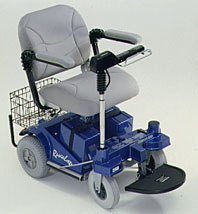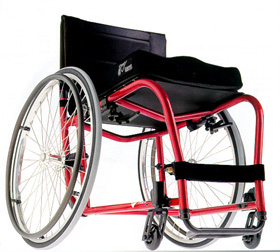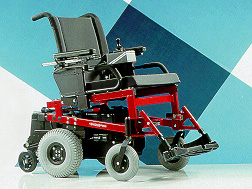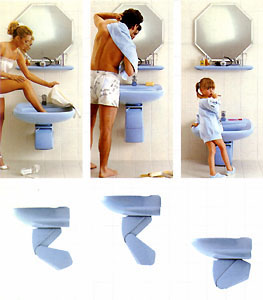
|
| Version
4.0 July 9, 2001 |
|
|
|
|
|
|
|
|
|
-
|
-
|
-
|
-
|
- © Edward Steinfeld and Danise
Levine, 2001
|
- Additional
Information
|
-
|
-
|
-
|
- Disability and the
Environment
|
-
|
-
|
-
|
-
|
- 6. Trends
|
-
|
-
|
-
|
-
|
- There are many technological and social trends that will have an
impact on how public housing authorities accommodate people with disabilities in the
future.
|
-
|
-
|
-
|
-
|
- Clearly, the aging of the population will increase the proportion of
older people in public housing above today's levels. The incidence of disability among the
older population is considerably higher than in the younger age groups. Thus, the demand
for accessible apartments will continue to increase as time goes on. The generation now
approaching old age is more affluent that the current elderly population but, inner
cities, where most public housing is located, have the greatest numbers of low income
individuals. Thus, the relatively greater affluence of this generation of elders is not
likely to reduce the demand among older people for accessible public housing units.
|
-
|
-
|
-
|
-
|
- Another social trend that will also have an impact is the reduction
in emphasis on long term nursing and rehabilitation care facilities. More and more
alternatives to nursing homes and acute care rehabilitation facilities are being developed
all the time. The emphasis on community based rehabilitation care and even a renewed
interest in house calls for physicians will enable many people with serious health
problems to remain living independently. In fact, due to managed care programs that reduce
health care options, many of these people will be forced to remain in independent housing
even if they would prefer to move to nursing care and intermediate care rehabilitation
facilities. We can expect to see this trend affect public housing tenants since government
agencies who serve low income people like the Veterans Administration, are embracing these
cost saving approaches to care rapidly.
|

Figure 3. Rascal electric scooter
|
-
|
-
|
-
|
- New wheelchair technology creates new requirements for space and equipment. For example,
scooters are becoming more and more popular to help people with walking limitations. These
devices are larger and require more space than the conventional electric wheelchair.
Although they are not intended for use in small spaces, many people do use them in the
kitchen and bathroom because they reduce the need for standing while preparing food or
grooming. These devices require more space for turning and approaching fixtures and they
make doors more difficult to open unless they are automated (Fig 3). Currently, the
accessibility codes do not address clearances for scooters but there is a gathering
momentum to do so.
|

Figure 4. Action Super Pro-T Manual wheelchair

Figure 5. Quickie P200 Power wheelchair
|
-
|
-
|
-
|
- Manual wheelchair design is also evolving. A study completed for the
New York Public Housing Authority found that lightweight, high performance chairs are
becoming more popular (Fig 4). These chairs are much more maneuverable and are much
shorter than other chairs but, because the wheels are cambered for improved performance,
they can be much wider than traditional models. Fortunately, the camber can usually be
adjusted easily for different conditions. The NYCHA study also found that the new
generation of power wheelchairs are more maneuverable than conventional models and do not
take up any more space (Fig 5).
|
|
|
|
- Other new assistive technology includes devices that help blind
people avoid obstacles and intelligent controls for power wheelchairs that remember
frequently used paths of travel. Such devices will allow greater independence for people
with severe disabilities.
|
|
|
|
- The continuing evolution of the independent living movement will have
a similar impact. Advances in independent living, particularly the availability of
widespread attendant care, if it comes to pass, will make it possible for many more
low-income individuals with disabilities to live in independent apartments.
|
|
|
|
|
- Another trend that will have an impact on public housing in the
future is the development of new codes and standards. Advocates for people with
disabilities are very active in promoting changes to codes and standards. The ANSI A117
Standard was recently revised to include many new requirements focused on access for
people with sensory impairments and people of short stature. The ADA Accessibility
Guidelines are under revision. It is likely that the technical criteria in the ADAAG will
be almost identical to the ANSI A117 1998 Standard when they are completed. New
construction, additions, and substantial rehabilitation will have to comply with new
requirements. The advent of an international building code in the next decade will bring
about another cycle of revision and open up more communication with the European Union and
Canada. This is likely to introduce some new methods for providing accessibility that, up
to now, have not been accepted in the U.S.
|

Figure 5. Height adjustable sink |
|
|
|
- Finally, one of the most important trends is the emergence of the
concept of universal design as an alternative to traditional accessible design. Universal
design is a process whereby environments and products are designed so they are usable by
all people, regardless of age and ability, at no additional cost to the user. The idea is
to create a physical environment that can be used by the broadest population possible.
Universal design is accessible design with a different attitude. In universal design, a
higher level of accessibility is built in from the start, often through flexibility and
adaptability (see Fig. 5).
|
|
|
|
- Universal design seeks to create mass-produced products, places and
systems that can reduce the need (although not eliminate it) for specialized assistive
products or accommodations for people with disabilities. The availability of a new
generation of universally designed products for making dwellings accessible and new codes
and standards that can be applied across the board in all units will increase the level of
accessibility in new construction and provide a host of new product options for
renovation.
|
|
|
|
|
- top of page | home | next
|



